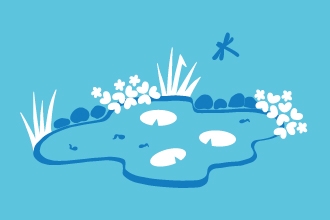The trainee team had been asked to clear Typha from in and around the pond at Monkwood. This would greatly benefit the great crested newts there, a key protected species there. Typha is the collective name for species such as reedmace or bullrush, which are perennial aquatic plants that can take over a pond if left unmanaged.
For the love of newts
Andy and the trainees by Catharine Jarvis
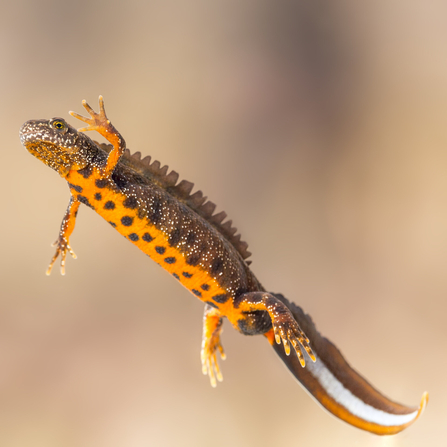
Great crested newt
Great crested newts are amphibians that live in and around a pond. Measuring up to 170mm, they're the largest UK newt species. They have a very dark brown-black bumpy skin and you may be familiar with images of breeding males, which have an iridescent stripe along their tail and a smooth crest that turns into a more jagged crest running along their backs.
They come to ponds to breed from March to June and then spend late summer and autumn feeding on invertebrates in nearby woodland, grassland, hedgerows and marshes. They hibernate underground in the winter months, among tree roots and in old walls. That’s why the Monkwood pond is perfect for them, as they have everything they need on their doorstep. As it was coming up to the start of their breeding season, time really was of the essence, as any habitat work we were doing had to be completed before they woke from their winter slumbers.
That’s why the Monkwood pond is perfect for great crested newts; they have everything they need on their doorstep.
It was almost Valentine’s Day so, for the love of newts, Carolyn, Katie, Romy and Andy clambered into their neoprene waders, to much laughter at the varying sizes ranging from tight-fit to ‘clown’ suits. We may have initially mocked Andy for bringing along his red marine naval survival suit but a sobering safety talk by him on the merits of wearing such a warm, dry suit on a marine geography trip in the Bristol Channel had us all wishing we had a similar get up as we stood by the icy pond.
Safety-conscious Andy donned a buoyancy aid and then walked a few feet into the murky water, breaking the thin ice with a spade. He also used the spade to test the depth, probing it in front of him. He only needed to wade out a metre and that was far enough for him to be able to demonstrate how to dig out the rhizomes of Typha. He worked round the root ball, vigorously cutting it with his spade before prising it up from the muddy pond bottom, lifting it out with his gloved hand and then throwing it to the side of the pond. This gave any creatures that were in the vegetation the opportunity of slithering back into the pond and away from all the action.
Once Andy had waded back to the water’s edge and Carolyn, Katie and Romy realised this really was happening and it wasn’t a bad dream, it was over to them to get on with the day’s task. I was just happy to be there as I should have been on an admin day but had been given the job of supporting them all, from the bank, whilst capturing the task on my mobile.
Carolyn was the ‘chosen one’ and was up first. As she tentatively took a few steps, I stood on the bank with one end of a rope in my hands; Carolyn was at the other end, rope around her waist. Carolyn’s job was to depth-test the first quarter of the pond, so that Romy and Katie would be aware of the depth and stay safe.
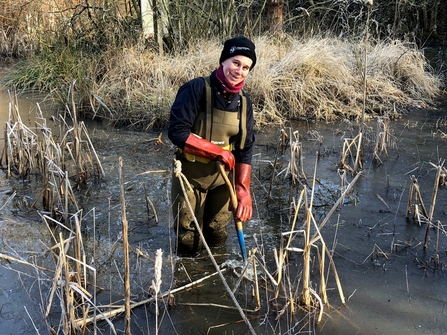
Carolyn in Monkwood pond by Catharine Jarvis
Carolyn copied Andy’s technique and used the spade to push into the water and down to the soft mud in front of her. She spent a good 20 minutes walking in a semi-circle identifying. nearly to her cost, that there was a deeper channel about two metres out. The murky water went above her knees on more than one occasion. We all kept Carolyn going with our usual trainee banter and the promise of one of Andy’s hot chocolate drinks when she had completed the task in hand.
It was really hard work, the ice was about an inch thick and depending how hard and at what angle Carolyn struck it with her spade, we had a sound effect not unlike breaking glass. Standing on the side of the pond, the earworm of Walking on Broken Glass by the Eurythmics started going round in my head. Andy thought it sounded more like nature’s version of Tubular Bells by Mike Oldfield.
Once the pond was deemed safe for Katie and Romy to enter too, they all got to work. Whilst Carolyn, Katie and Romy dug out the roots, Andy and I winched some root balls to the side. Out came the large metal grappling hooks on a long piece of rope. Andy tied one end of the rope around my left hand and, after shouting a warning to the pond dwellers, I threw the hook out into the water with my right hand. I had to let the hook sink for a count of five and then slowly drag it along the bottom of the pond, collecting pieces of rhizome as I pulled the hook to the water’s edge. I had a couple of near misses when I nearly over extended but thankfully didn’t dive headlong into the pond.
I did this repeatedly for a good hour, throwing the hook, then dragging it and its contents to the water’s edge. There were cheers when I managed to connect with a clump of rhizome that one of the trainees had freed and haul it to the side. It was a good workout in nature’s gym!
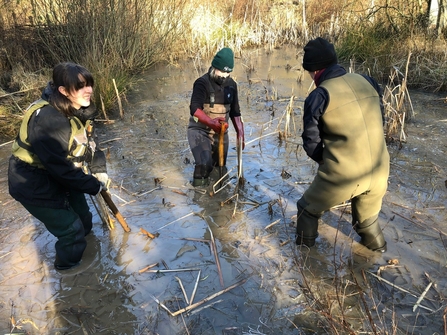
Getting to grips with Typha by Catharine Jarvis
Now that the trainees were all in the pond, they just wanted to get the task over with as soon as possible so, instead of stopping for a drink, we all agreed to carry on working until 1pm when we could stop for lunch. This came round quickly and as we sat on the bank having lunch, we congratulated ourselves on a job well done. The reeds had been cleared and this would mean sunlight would be able to reach the water and offer a much better habitat for great crested newts. After lunch (and a much deserved hot chocolate and Eccles cake from Andy) we were ready to start up again.
Katie and Romy waded out to the small island, taking a bowsaw and a pruning saw with them. Their task was to cut down seven wispy trees near to a young oak tree, so that more sunlight could get to the water below.
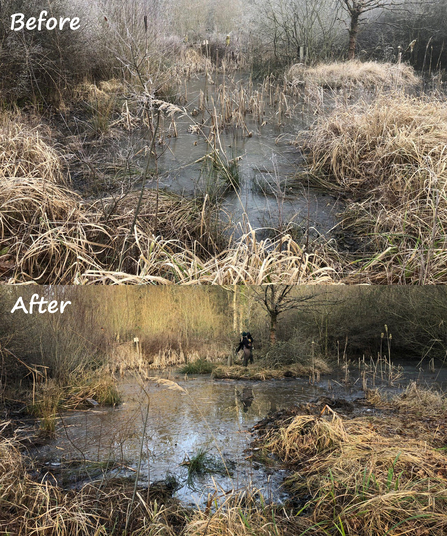
Monkwood pond before and after by Catharine Jarvis
I carried on working with Carolyn and Andy, extracting more Typha from the pond and dragging it to the side. We all worked on in the sunshine until around 2.30pm, when it was time to start packing up and making trips back to the Land Rover. It always amazes me how much equipment we need for a job; the back of the Land Rover is usually full to the gunnels. I put that down to Andy’s logistics brain as we always take out exactly the right tools for the job and I can’t recall ever uttering the words “if only we had brought …..”. 10 trips later, with my arms feeling longer than they had been in the morning, and we were all back in the Land Rover heading back to Lower Smite Farm.
I expect by now, the great crested newts will be returning to Monkwood's pond to spend the spring and summer months happily swimming around, in better oxygenated water and with more space to explore and bask in the sunshine, thanks to our work. Next time you take a walk around Monkwood, stop to look over the wicker screen around the pond to see if you can see any movement in the pond. Happy newt spotting.



